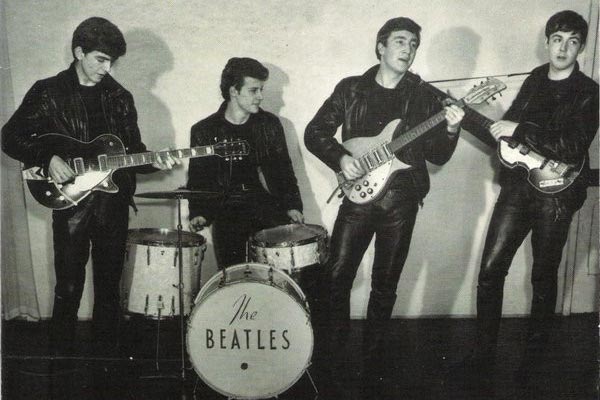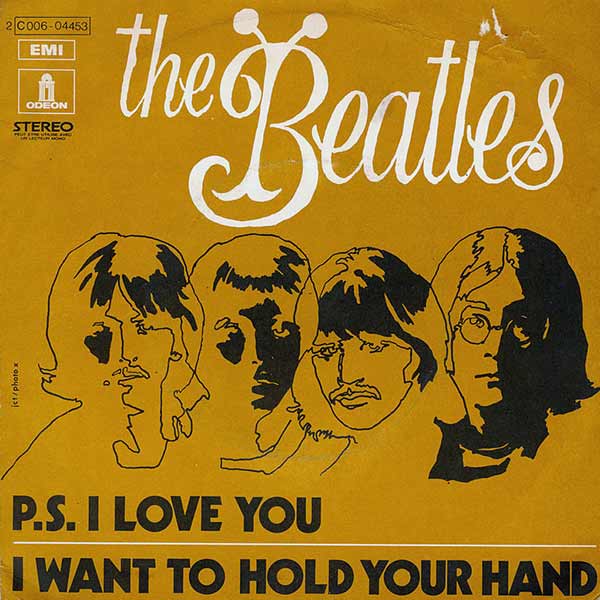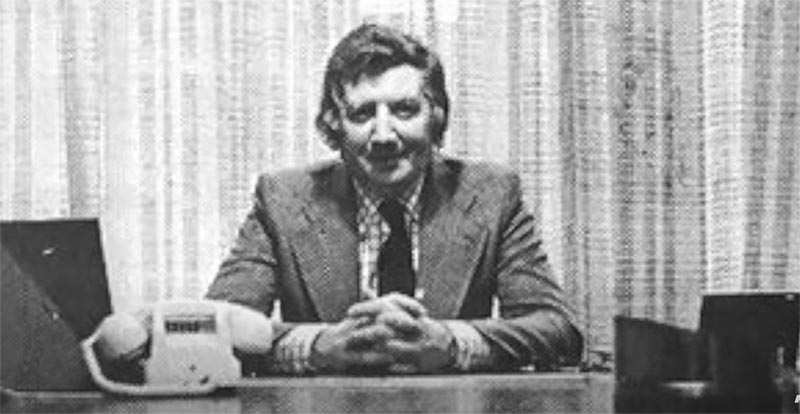HANG A SIGN ON ME: The Evolution of the Beatles Logo
The Beatles’ iconic and memorable logo was created on a whim by a drum store owner for a shockingly small amount of money — which took years to refine and decades to be adapted as their official logo.

The logo is seen on almost every piece of merchandise issued since 1994’s Anthology project. It appears in some form on just about every music collection they release. But it wasn’t originally to be used that way.

Paul photographed with the first version of the Beatles drum kit logo, 1960
It also was not the first “logo” the Beatles used. This 1960 photo shows Paul with a drum head featuring a very simple sign which might barely be considered a logo. It looks to be a sheet of paper taped to the drum head, with the Beatles name written in lowercase followed by a very understated period. Although this photo dates from the time period in which the Beatles played their residency at the Indra Club in Hamburg, photos of the band from the Indra Club (as well as their residencies at the Top Ten Club in 1961 and the Star Club in 1962) show a plain white bass drum.

The Beatles with Pete Best and the 2nd logo version
Their second logo was much more stylized, featuring a script “The” and a san serif “BEATLES” in all caps. This logo is seen in very few publicity photos of the band from around 1961; most of the promotional stills and live, on-stage photos show a plain white drum.
The penultimate logo was the “bug” logo, which featured antennae stemming from the “B” and which was used for fan club material even after the “drop T” logo was adapted. It was created out of necessity; up to that point, Ringo’s bass drum displayed his name.

Ringo Starr and his self-labelled drum, seen in photos of the band on stage at the Cavern Club
As the Beatles began their 1963 tour with Helen Shapiro, concern that people might think that the entire band was called Ringo Starr prompted Paul to sketch out some new logo ideas which were given to Liverpool artist Tex O’Hara for further development.
“We played around with different ideas to find out which ones they liked. I did about five to ten drawings – which I’ve still got – and showed them to the group. They settled on one logo, which was put on a piece of linen and stretched across the front of the drum.” — Tex O’Hara

Original Tex O’Hara Beatles logo sketches — these sketches sold in 2010 for £ 8,400 ($9,566 US)
That linen and the way it was affixed to the drum is clearly seen in this photo from the Beatles’ appearance on Thank Your Lucky Stars:

Beatles “bug” logo as seen on Thank Your Lucky Stars, February 17, 1963
The “bug” logo can also be seen in photos from the Beatles’ residency at the Cavern Club during 1962. It continued to be used in the official fan club logo even after the “drop T” version had been adopted.

Beatles fan club card featuring the “bug” logo

The “bug” logo was used on the 1973 French single for P.S. I Love You
The final logo — the most familiar Beatles logo, known as the “drop T” version — was designed by Ivor Arbiter, founder of a London drum store known as Drum City. Ringo and Beatles manager Brian Epstein visited Drum City about a month after the Please Please Me LP was released, although Arbiter said,
“I had a phone call from the shop to say that someone called Brian Epstein was there with a drummer. Here was this drummer, Ringo, Schmingo, whatever his name was. At that time I certainly hadn’t heard of The Beatles. Every band was going to be big in those days!”

Ivor Arbiter
Some haggling took place, as Epstein did not want to have to pay for the drums and thought it sufficient that trading Ringo’s old Premier kit should make them square. Arbiter agreed to the trade but on the condition that the Ludwig logo appeared on the bass drum. Epstein accepted Arbiter’s terms, but insisted that the Beatles’ name also be featured prominently. Arbiter created the famous “drop T” logo — emphasizing the “beat” in their name — for a £5 fee, sketching it on the back of a package of cigarettes. It was painted it on the drum by local sign painter Eddie Stokes.
Interestingly, Ringo himself tells a different version of events, claiming that Arbiter was about the remove the Ludwig logo from the drum but Ringo wanted it left on. However, by many accounts Ludwig drums did not feature the Ludwig logo on them at that time and it had to be painted on.
“I took his old Premier drum kit from him and brought it back to the store. We renovated it in our workshop, and then sold it. I ripped off the bit of material from the bass drum head where he’d handwritten the Beatles’ name and threw it away. It was a terrible drum kit. It wasn’t old: he’d only had it six months or a year. But it was a brown finish, one of the worst finishes that Premier ever did…I don’t know why he got it in the first place, really. No wonder he wanted to change it. Anyway, we cleaned it up and sold it off the same week — and very, very cheaply. It would most likely be a collector’s item if we still had it today.” — Gerry Evans, Drum City store manager
The new set including that bass drum was personally delivered by Evans to the set of the ITV program Thank Your Lucky Stars on May 12, 1963, and was used for the first time for a taped appearance that evening.
The logo went through some minor revisions in the next few years, most notably in the differences in the thickness of the letters. The best-researched account by Beatles collector Russ Lease puts the number at seven versions of this logo as they originally appeared on Ringo’s bass drum:

The seven versions of The Beatles “drop T” logo
- The original as created by Ivor Arbiter and painted by Eddie Stokes (April 1963)
- “The Sullivan Head” — purchased new in New York and used on their first appearance on the Ed Sullivan Show (January 1964)
- “The Hard Days Night Head” — purchased new for use in their film A Hard Day’s Night (April 1964)
- First US Tour Head (May 1964)
- The 1965 US Tour Head — featuring a sticker of the Ludwig logo (August 1965)
- The 1966 US Tour Head (November 1965)
- The Let It Be Head — Very briefly shown at the beginning of the original Let It Be film and not actually attached to the drum (January 1969)
Yet another version of the “drop T” logo was found on the compilation LPs Past Masters Volume 1 and 2 (and the double LP Past Masters Volumes 1 & 2). Notice that the word “The” lacks serifs and the letters in “Beatles” are connected:

As ubiquitous as the “drop T” logo is, it never appeared on a Beatles album released during their career (although it did make an appearance in a stage photo on the inside cover of Beatles For Sale) and was not shown on an album cover until the 1980 compilation The Beatles Box. Incredibly, wasn’t even trademarked by Apple until preparations for the 1994 Anthology project, hence the variations that ran all the way through 1988. That official trademarked logo used in all materials today most closely retains the look of final touring version from 1966:

Vinyl Rewind has a great piece on the origin of the drum and “drop T” logo:


